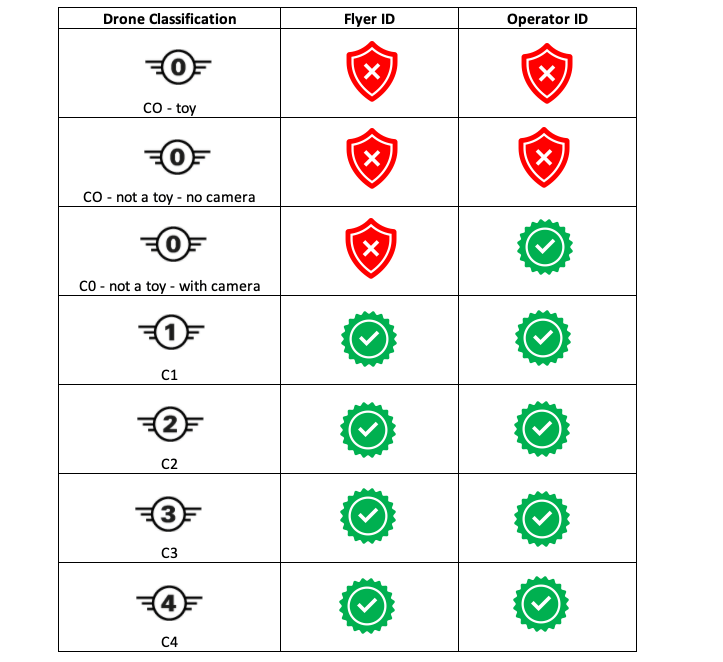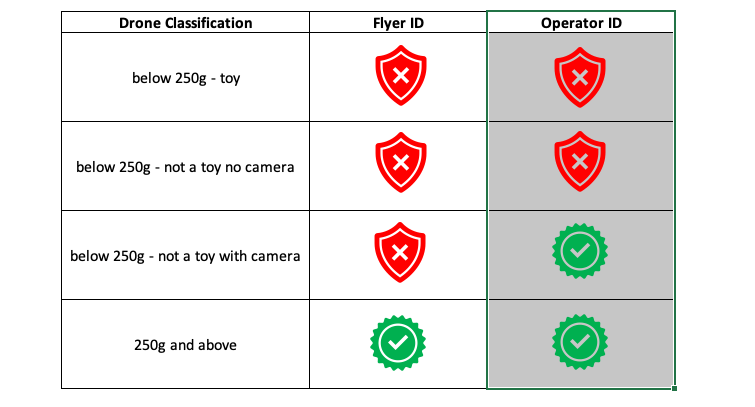April 7, 2021
Ready to fly a drone?
Do you want to start taking photos or video with a drone? What you need in the UK to be ready to fly legally

You can’t have failed to notice the increase in drone photography and videography. The change in perspective of familiar scenes by being in the air can give your photos a new lease of life. However, recently, there was a change in the law that means you may need to have the authorisation to fly even small drones legally. This week we’ll look at the different accreditation types that you can get to literally lift your photography into the air.
Drone Classifications and CAA ID’s
The UK Civil Aviation Authority (CAA) introduced the Drone and Model Aircraft Code in October 2020. Part of this code has created a new set of classifications for drones (or, in the legal jargon, Unmanned Aerial Vehicles or UAV’s for short). The classifications will soon be appearing on the boxes of every drone sold in the UK. Depending on the classification given to each drone model, there may be a requirement to have two different types of IDs issued by the CAA.
A Flyer ID is required if you want to fly certain types of drone. You can get one by sitting an online test free of charge and lasts for five years, and then it will need to be renewed. An Operator ID is only required for the owner of certain drone types and has a small fee of £9 per year. The Operator ID means that you have the responsibility to ensure that the drone is maintained correctly and is fit to fly.
The need for the different ID’s is summarised in the chart below;

That’s all nice and easy, then? It would be if the drones you could buy today had the classification symbol on the boxes. However, they don’t. So, for the next two years, there is a legacy drone classification that you’ll need to follow that is based on the flying weight;

That’s cleared everything up then, at least for 2021 and 2022. Again, not exactly. The definition of a toy isn’t set in stone either. The CAA advice is that a drone is a toy if;
- the manufacturer or store you bought it from describes it as a toy
- you bought it from a toy department or retailer
- it is marked as suitable for below age 14 or a younger age group
- it was advertised or packaged to attract children
My advice is if you aren’t sure if it is a toy or not, then assume it isn’t a toy. It’s going to save you a whole lot of arguing in the future should anything go wrong and you end up in court. The other thing that you’ll need to be aware of is the take-off weight of your drone. The DJI Mini 2 advertises as a sub 250g drone, so that means that you’ll only need an operator ID and not have to sit the test for a flyer ID. However, check the specifications, and the weight of 242g includes the weight of the drone, the battery and the propellors. If you add the propellor guards, it is now over 250g and needs a flyer ID.
The last thing to be aware of is that once you have an Operator ID, any drone you are responsible for must have a label with your Operator ID in text, at least 3mm tall. Just adding a piece of paper with tape could add a few extra grammes to the take-off weight.
Where can I fly my drone?
You’ve got the relevant ID now from the CAA, so off you go flying anywhere you like. Again, the rules aren’t quite as simple as that. There are three categories, and one of them has a further three sub-categories, depending on the type of flying that you’ll be doing.

If you have the necessary Flyer ID for your drone’s weight, you can fly in the Open A1 and A3 categories. However, if you want to fly closer to people, then there is another exam that you’ll need to pass called the A2 Certificate of Competency. We’ll look at this a little more at the end of the blog.
You are probably asking what does ‘close to people’ actually mean? Thankfully, the CAA is very clear on this based on the classification of drone you are flying. Honestly, this is the final set of charts to summarise what you can and can’t do. There are three versions based on if you have a ‘new’ classification of drone (trust me, you don’t – there are none available) or if you have a legacy drone. There are rules for the next two years of transition for the legacy drones and then the ongoing rules for legacy drones.
Classified Drone

Transition Drones until 2023

Legacy Drones 2023 and onwards

If you want to fly a drone outside any of the definitions set out above, then you’ll be flying in the Specific Category and not the Open Category. To do this, you would need to pass a different exam called the GVC (General Visual-Line-of-sight Certificate) and obtain Operational Authorisation from the CAA. The GVC would be more suited for commercial drone operations, so I won’t go into it in further detail today.
Sitting tests
We have looked at three different tests that you may need to sit to be accredited to do certain types of flying. To obtain your Flyer ID, you will need to sit the DMARES (Drone and Model Aircraft Registration and Education Service) test. There is an online learning module and test available after you register at https://register-drones.caa.co.uk/individual/register-and-take-test-to-fly
If you want to fly closer to people (remember that means that you’ll be able to fly 50m from uninvolved people as opposed to 150m), then you’ll need to sit the A2 Certificate of Competency. It requires a lot more knowledge of the laws that control flying UAV’s as well as demonstrating a basic understanding of meteorology and the physics of flying. As there is more knowledge required and additional risk to the public, the exams are under closed-book conditions. For this reason, the CAA has accredited several training providers who can administer the exam process.
Search for A2 C of C accreditation on a search engine, and you’ll find the trainers that can take you through the whole process of training and sitting the exam. I have used UAVHUB and can thoroughly recommend the level of training that they offer. The training package and exam fee are around £99. I have seen all kinds of training in my previous roles, and the UAVHUB package gives you everything you’ll need to know in a simple way. The entire process is online, with around 5 hours of training material and mock tests to prepare you for the exam.
When ready, book your exam and ensure that you have a laptop or computer with a detachable webcam. The exam proctor will check that the room you are sitting in doesn’t have any material for you to ‘cheat’ before sitting the multiple-choice test. You need 80% to pass the test, and UAVHUB has a 99.9% pass rate. If you want to fly closer to people, then the A2 C of C is a relatively simple process as long as you can spare a day to learn the vital safety information for flying.
Give us your feedback
If you’ve got any questions or comments, leave them below. You can sign up for the Edinburgh Photography Workshop monthly newsletter, where you’ll get regular updates on exciting things happening in photography and some great tips. Sign up by clicking here.
About the author
As well as running Edinburgh Photography Workshop, Rich Dyson is a professional photographer. His photographs are regularly used in newspapers such as The Times, Guardian and Daily Telegraph. He also had two solo exhibitions as well as being featured in a members sponsored exhibition in the Scottish Parliament. You can see and buy his photography at richdysonphotography.com
